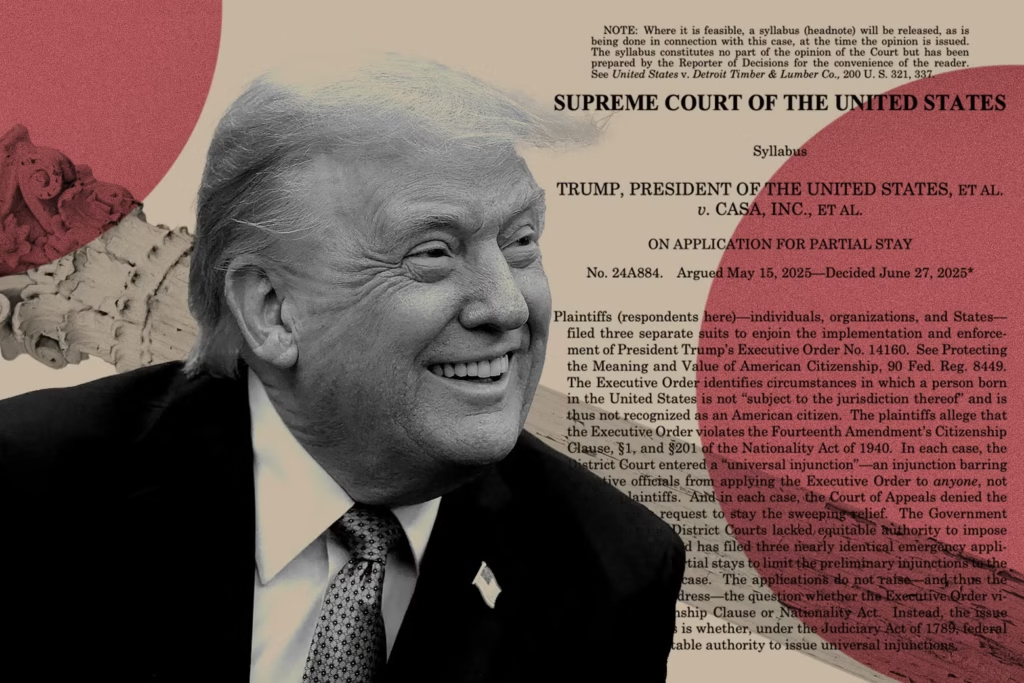What happens when Trump’s tariffs slam into the Supreme Court?
Will nine robed justices protect presidential power—or pull the plug on it?
The stakes? America’s economy, politics, and maybe the future of the presidency itself.
Nobody’s ready for how close this fight really is.

Table of Contents
Courtroom Clash, Numbers Dash

- On Trump’s tariffs, both the trial court and the appeals court said “unconstitutional.”
- But hold up—there’s a twist.
- The appeals ruling wasn’t unanimous.
- Out of 11 judges, seven called it unconstitutional, while four said the president had wiggle room.
- With eight Democratic appointees and three Republican ones, the 7-4 split let Trump crown one Democrat judge a “patriot.”
Nine on High, Final Say

- That split set the stage for everyone to dissect the Supreme Court justices’ leanings.
- The U.S. Supreme Court has nine members: eight associate justices and one Chief Justice.
- Think of it as America’s ultimate court—no higher bench.
- Their decisions are final and, thanks to precedent, become the law of the land.

Trump’s Triple Play
- Justices hold lifetime seats, and for years it was five liberals, four conservatives.
- Then in 2016, Justice Scalia, a conservative, passed away.
- Presidents nominate, the Senate confirms.
- Obama nominated Merrick Garland, but the Republican Senate said “nah.”
- Confirming Garland would have tipped the balance liberal, and Republicans weren’t having it.
- They stalled until Trump won the White House.
- Trump dropped Garland, picked a conservative, and kept the 5-4 split.
- In 2018, another liberal justice retired.
- Trump picked Brett Kavanaugh, flipping the balance to 5 conservatives vs. 4 liberals.
- In 2020, liberal Justice Ginsburg passed away.
- The election was just two months away.
- Democrats cried foul, pointing to the Garland precedent.
- Trump didn’t care—he raced ahead.
- He pushed through Amy Coney Barrett, a devout conservative.
- Trump left office with a 6-3 conservative majority.
- That 6-3 bench later ruled in his favor on presidential immunity.
- All six conservatives backed him, all three liberals opposed—straight down party lines.
- That 6-3 split still stands today.

- Conservatives hold sway, but some say the tariff case isn’t so clear-cut.
- Kagan, Sotomayor, and Jackson are firmly liberal.
- They’re expected to oppose Trump’s tariffs.
- Among conservatives, four lean Trump’s way.
- Kavanaugh, Thomas, Gorsuch, and Alito see tariffs as executive discretion.
- They’ve backed similar government power before.
- That makes it 3 liberals vs. 4 conservatives—two justices left in the middle.
Roberts Rules, Barrett Schools
- Chief Justice Roberts is conservative but puts the law first.
- And the law is clear: only Congress can levy taxes, not the president.
- Roberts is more likely to follow the legal logic than political pressure.
- Then there’s Amy Coney Barrett.
- She’s Trump’s 2020 pick.
- Barrett leans on the Major Questions Doctrine—when it’s a big national issue, Congress must say so clearly.
- The idea: if it’s huge, the Court checks the president unless Congress gives the green light.
- Barrett even uses parenting metaphors:
- “Let the kids have fun” doesn’t mean buy them hotel rooms and theme park tickets.
- “Buy some apples” doesn’t mean order a thousand.
- Translation: major policies need Congress’s explicit approval.
- Barrett’s conservative, but under MQD, she could break ranks.

Lady Justice, Literally
- Look at it another way—it gets interesting.
- The three liberals plus Barrett, the swing vote, are all women.
- The four staunch conservatives plus Roberts are all men.
- So, when will we actually get a ruling?
- Unlike some courts, the U.S. Supreme Court doesn’t take thousands of cases a year.
- Four of nine justices must agree to hear a case.
- About 9,000 cases knock on the door each year—only around 80 to 100 make it in.
- The Court filters out the small stuff, focusing only on legally and socially big cases.

Summer Snooze, Fall News
- Right now, the justices are on summer recess.
- From early July to late September, the Court takes a break.
- They regroup on Monday, September 29, 2025, for the Long Conference.
- That’s when they sort through the backlog.
- It’s a private meeting of the nine justices—no outsiders.
- The Court officially reopens the first Monday in October.
- s
- The October 14 appellate deadline was set with this schedule in mind.
- Because tariffs are a blockbuster issue, odds are high it gets picked up at the Long Conference.
- If so, arguments start in October, and a ruling could drop by late 2025—or early 2026 at the latest.
The Final Flip or a Quick Slip?

Looking at that 7–4 split in the appeals court, one thing’s clear: the Supreme Court fight won’t be decided until the very last swing. But don’t hold your breath—the earliest ruling won’t land until year’s end.
There’s one twist: if the case doesn’t get picked up at the Long Conference, the appeals court ruling becomes final on the spot. That means a verdict could drop as early as late September or early October. Still, because tariffs are such a political and economic powder keg, the odds of the justices passing on it are slim.
Discover more from Alphazen Dynamics
Subscribe to get the latest posts sent to your email.



